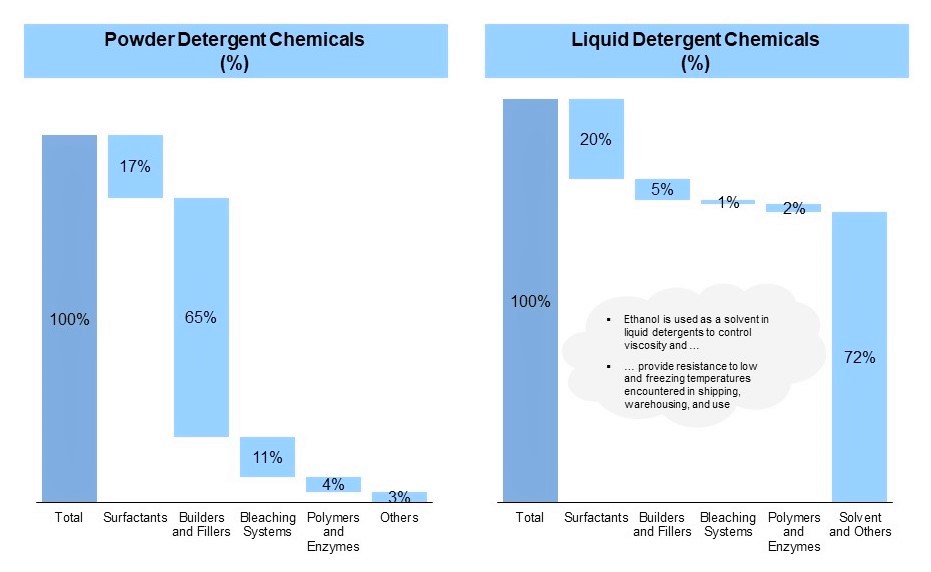
There are two forms of detergents that dominate the global laundry market – liquid and powder detergents. Liquid detergents are more effective for lifting out everyday stains and ground-in dirt while powder detergents are better with food, greasy, or oily stains. While liquid detergents are mostly common in the U.S., powder detergents are popular elsewhere in the world like India, China, Africa, Latin America, Europe and, other developing countries. Liquids and powders have different chemical compositions and abilities to clean a fabric.
Even so, all detergents share a common compositional framework. Four major type of chemicals found in a detergent are surfactants, builders and fillers, bleaching systems, and polymers and enzymes. Other chemicals in a detergent may include antifoamers, brighteners, complexing agents, and hydrotropes.

Surfactant molecules usually dissolve in water at one end and the other end locks the oily substances removing them from clothes. For powdered detergents, the main surfactant is linear alkylbenzene sulfonate (LAS) that is effective on dirt but less effective on greasy or oily stains. Liquid detergents commonly have a higher level and a broader range of surfactant content than powders including LAS, alcohol ethoxylates, ether sulfates, and amine oxides. Amine oxides, which are effective on grease, are liquids themselves and can’t easily be formulated into a powder. Further, liquids also contain alcohol ethoxylates, which are effective on challenging oily stains. Choosing the right surfactant category and structure is an essential part of making liquid detergents and addition of viscosity control agents such as sodium xylene sulfonate may also be required.
Builders on the other hand form complexes with metal ions to soften water and optimize pH. Liquid detergents don’t need as much builders because their surfactants are less sensitive to water hardness. To build liquid detergents, especially for hard water, formulators must add alternative builders such as sodium citrate to increase surfactant levels. However, powders contain a good amount of cheap builder.Fillers on the other hand are bulking agents. The main filler in powders is sodium sulfate while the primary filler in liquid detergents is water.
The next chemical found in a detergent is a bleaching agent that oxidizes molecules to remove stains. In powders, peroxygen compounds activate in water to release hydrogen peroxide which is an oxidizing agent. Most premium powdered laundry detergents contain the oxygen-based bleach sodium percarbonate and usually tetraacetylethylenediamine (TAED) a chemical, that activates bleach at low temperatures. Sodium percarbonate may react with other ingredients in liquid detergents. So alternative enzymes, optical brighteners, and additives such as disodium diaminostilbene disulfonate are used in liquid detergents to stabilize them.
Further, polymers in detergents help keep dirt suspended. Common polymers for this purpose are polycarboxylates such as sodium polyacrylate and ethoxylated polyethyleneimines.
Finally, enzymes break down protein, starch and saccharide-based stains. Liquid detergent must contain additives such as borax and calcium formate for enzymes to be stable. Powder detergents can reduce soil redeposition by adding a simple acrylic homopolymer complexing agent but acrylics don’t blend well in liquids. Therefore, liquids need addition of expensive complexing polymers such as polyethyleneimine ethoxylate. This make liquids highly effective but typically more expensive than powders.
In summary, different chemical compositions in liquid and powder detergents make them perform well one over the other based on the consumer preference. Liquids will typically be preferred for removing everyday dirt while powders will serve the purpose when it comes to removing oily stains and greases.
ADI Chemical Market Resources is actively researching the polymer and chemical markets and applications. With over 500 projects our clients span the entire chemical value chain with profiles such as chemical industry stakeholders including distributors, end-users, EPC companies and technology licensors, traders, private equity and venture capital investors. Visit www.adi-cmr.com and contact us at info@adi-cmr.com or +1 281 506 8234 to learn more.
– Swati Singh and Uday Turaga



















